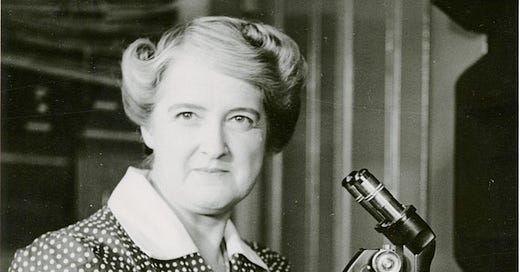Today is Women's Equality Day
USDA celebrates by sharing information on former head scientist Eloise Cram
By Denise Rivette
Women's Equality Day is celebrated in the United States on August 26 to commemorate the 1920 adoption of the Nineteenth Amendment to the United States Constitution, prohibiting states and the federal government from denying the right to vote to citizens of the United States on the basis of sex. Although the 19th Amendment was ratified on August 18, 1920, it was not until it was ratified by a two-thirds majority of states on August 26, that it was officially enacted. According to the National Women’s History Alliance, “This was the culmination of a massive, peaceful civil rights movement (the Suffragette Movement) by women that had its formal beginnings in 1848 at the world’s first women’s rights convention, in Seneca Falls, New York.” In 1971, Representative Bella Abzug (D-NY) began advocating for August 26 to be designated as Women’s Equality Day. Congress did so in 1973.
This year to celebrate the day, the U.S. Department of Agriculture (USDA) sent an email celebrating one of their own. “Eloise Cram, Ph.D., an international authority on worm parasite diseases, spent over 30 years in the Federal government. Dr. Cram became Head Scientist for parasite investigations in poultry and game birds with the USDA's Bureau of Animal Industry (BAI). Leaving USDA to join the National Institutes of Health (NIH), Dr. Cram pioneered research into schistosomiasis, an infection caused by parasitic worms. Towards the end of her career, Dr. Cram was the first woman president of the American Society of Parasitologists.”
Their website provides more information on this accomplished scientist. “Eloise Blaine Cram (1897-1957) entered government service as a zoologist for the U.S. Department of Agriculture's (USDA) Bureau of Animal Industry (BAI), where she became noted as a world authority on the parasites of poultry. She eventually became USDA's head scientist for the investigation of parasites in poultry and game birds. In 1936, she took a position at the zoology laboratory at the National Institutes of Health (NIH), where she studied pinworm and researched the control of the helminthic disease, schistosomiasis.”
”Eloise Blaine Cram was born in Davenport, Iowa in 1897. She graduated Phi Beta Kappa from the University of Chicago in 1919, and received her Ph.D. from George Washington University in 1925. In 1920 (the same year the 19th Amendment was ratified), Cram entered government service as a zoologist for the USDA's Bureau of Animal Industry (BAI), where she became noted as a world authority on the parasites of poultry, and eventually rose to the position of Head, Parasites of Poultry and Game Birds.
In 1936, Cram left the BAI to take a position at the Zoology Lab of the National Institutes of Health, where she remained until her retirement in 1956. While at the NIH, Cram contributed to the scientific study of pinworm, but her major contribution to parasitology and to science in general was her pioneering research into the curbing of the helminthic (produced by worms) disease Schistosomiasis. She made intense studies of the snails that transmit the often-fatal disease to humans and aided in reducing the health threat caused by the disease.
By the time of her retirement, Cram had produced over 160 papers and monographs on various subjects relating to animal parasitology, had become an international authority on helminthic diseases, and was working in the NIH's lab on tropical diseases. In 1955, the year before her retirement, she served a term as the only woman president of the American Society of Parasitologists. She died in San Diego, California, on February 9, 1957.”




